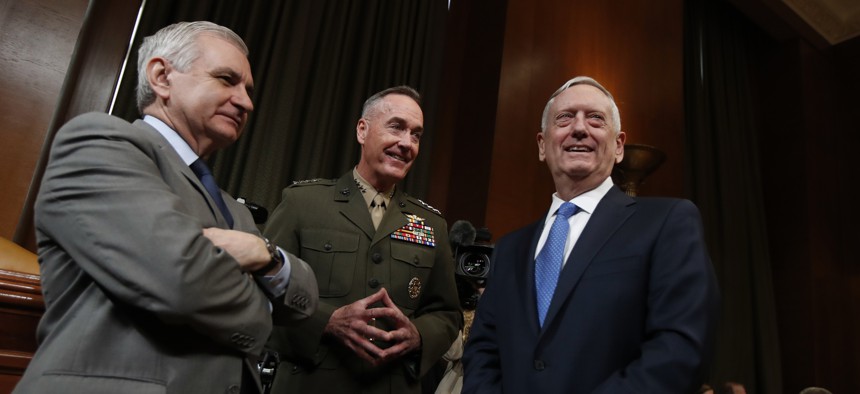
Joint Chiefs Chairman Gen. Joseph Dunford and Defense Secretary Jim Mattis confer with Sen. Jack Reed, D-R.I. (left), before testifying at the Senate Appropriations defense subcommittee. Manuel Balce Ceneta/AP
Would Better Messaging Help the Military Boost Its Budget?
Even if Pentagon leaders clarified their ‘readiness’ warnings, they’d still face an uphill battle for more funding in 2017.
If military leaders hope to convince Congress to fund the $30 billion supplemental that the Trump administration has requested for 2017 — let alone a larger plus-up the following year — they’ll need to better describe the readiness woes that the extra money would fix.
And that’s something military leaders have struggled with for several years, says Rep. Mac Thornberry, R-Texas, who chairs the House Armed Services Committee.
“We need to do a better job of making readiness problems real — more concrete, not just a chart that is three different colors, but explaining what we’re really talking about,” Thornberry told reporters Wednesday morning. “I’m not sure we’ve done well enough with that with members of the Armed Services committee. Much less our colleagues. Much, much less the public at large.”
One problem, Thornberry said, was that the need to describe readiness gaps runs counter to military officials’ hesitation to reveal them.
“Some of it comes out in public hearings, but understandably the military is somewhat reluctant to talk too much about vulnerabilities because then you’re telling the enemies what our weaknesses are,” he said. “The damage is deeper than most of us realize.”
Hours later, when the new Defense Secretary Jim Mattis and the Chairman of the Joint Chiefs Gen. Joseph Dunford settled in before the Senate Appropriations Committee’s defense panel, Mattis ran smack into that classification wall.
“There are specific readiness gaps across our forces which I would prefer to address in closed session,” he told the committee in his opening remarks.
But those concerns haven’t prevented generals from painting vivid pictures before: In a February HASC hearing, the Army’s vice chief of staff dropped the headline-grabbing assessment that only three of the Army’s 58 Brigade Combat Teams could “fight tonight.”
And in Wednesday's hearing, Dunford highlighted an area of need as “critical” as it is fundamental: ammunition. Another example he mentioned:
“What you find is that a squadron, for example, a Navy squadron down at Naval Air Station Oceana, that rates 10 aircraft, actually only has five ready-basic aircraft in the squadron. So again — [we] can't go to war with five of 10 aircraft.”
Still, pushback from Sens. Dick Durbin, D-Ill., Jack Reed, D-R.I., and other Democratic senators shows that stronger messaging on readiness alone won’t push the $30-billion request through. In Durbin’s list of four problems with the supplemental, he said it “appears to do very little to restore readiness … in the short term.”
“Congress has already addressed $5 billion of the requested funds in the pending defense appropriations bill,” he said. “Of the remaining funding, only about $8 billion is for near-term training and maintenance.”
That concern, plus the $18 billion in cuts to domestic spending that Trump proposed to help pay for the defense boost, make the supplemental’s path difficult.
“I think we do all appreciate the readiness challenges after more than a decade at war and constant effort,” Reed said. “And we want to address those, but we have these huge issues of what's the pay-for?”
Time is running out. With just over half of fiscal 2017 already gone, the House passed a $578-billion defense appropriations bill earlier this month, but has yet to vote on bills to fund the rest of the government. Senate Democrats, at least, are extremely reluctant to pass the defense bill without its peers.
And even if military leaders convince lawmakers that the problems they describe are real, the proposals for the 2017 supplemental and 2018 defense increases are largely than legally allowed by the six-year-old Budget Control Act.
For his part, Mattis evinced little patience for the law or the budget caps it requires: “It has done more damage to our readiness, sir, than the enemies in the field.”
NEXT STORY: What One Joint Chief Of Staff Thinks of Trump




